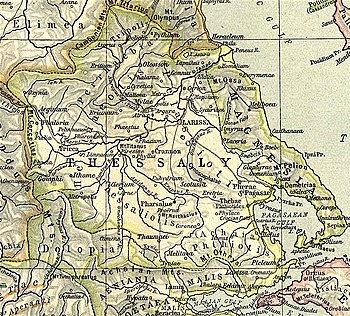
Asterium or Asterion (Ancient Greek: τὸ Ἀστέριον) was a city in ancient Thessaly mentioned in the Catalogue of Ships in Homer's Iliad as belonging to Eurypylus.[1] Homer speaks of "Asterium and the white summits of Titanus – Ἀστέριον Τιτάνοιό τε λευκὰ κάρηνα.[1] Strabo places the city in the neighbourhood of Cierium.[2] Stephanus of Byzantium relates that the place was later called Peiresia (Πειρεσία),[3][4] no doubt from the Argonautica of Apollonius of Rhodes who describes the place as near the junction of rivers Apidanus (the modern Pharsalitis) and Enipeus.[5]
Strabo, who places Titanus near Arne, also speaks of its white colour.[6] Peiresiae is said by Apollonius to have been near Mount Phylleium.[7] Near Mount Phylleium Strabo places a city Phyllus, noted for a temple of Apollo Phylleius.[8] Statius calls this city Phylli.[9] William Smith conjectures that the town of Iresiae mentioned by Livy,[10] is perhaps a false reading for Peiresiae;[11] however, modern scholars treat the town as distinct from Peiresiae and suggest the site is to be found in Magnesia not at Peiresiae.[12]
Under its later name, Peiresia, the town was a polis (city-state), and minted silver coins with the legend «ΠΕΙΡΑΣΙΕΩΝ».[13]
The editors of the Barrington Atlas of the Greek and Roman World identify Asterium's location at the modern village of Sykies (Συκιές) in the municipal unit of Fyllo, municipality of Palamas, Karditsa.[12]
- ^ a b Homer. Iliad. Vol. II.735.
- ^ Strabo. Geographica. Vol. X., p. 438. Page numbers refer to those of Isaac Casaubon's edition.
- ^ Stephanus of Byzantium. Ethnica. Vol. s.v. Ἀστέριον.
- ^ Eugen Oberhummer: Asterion 1.(in German) In: Realencyclopädie der classischen Altertumswissenschaft (RE). Vol. II,2, Stuttgart 1896, col. 1784.
- ^ Apollonius of Rhodes. Argonautica. Vol. I.35.
- ^ Strabo. Geographica. Vol. ix. p.439. Page numbers refer to those of Isaac Casaubon's edition.
- ^ Apollonius of Rhodes. Argonautica. Vol. I.35.
- ^ Strabo. Geographica. Vol. ix. p.439. Page numbers refer to those of Isaac Casaubon's edition.
- ^ Stat. Theb. 4.45.
- ^ Livy. Ab urbe condita Libri [History of Rome]. Vol. 32.13.
- ^
 Smith, William, ed. (1854–1857). "Asterium". Dictionary of Greek and Roman Geography. London: John Murray.
Smith, William, ed. (1854–1857). "Asterium". Dictionary of Greek and Roman Geography. London: John Murray.
- ^ a b Richard Talbert, ed. (2000). Barrington Atlas of the Greek and Roman World. Princeton University Press. p. 55, and directory notes accompanying. ISBN 978-0-691-03169-9.
- ^ Mogens Herman Hansen & Thomas Heine Nielsen (2004). "Thessaly and Adjacent Regions". An inventory of archaic and classical poleis. New York: Oxford University Press. p. 700. ISBN 0-19-814099-1.